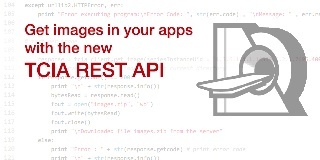| Panel | ||||
|---|---|---|---|---|
|
Summary
This document describes v4 of the TCIA programmatic Interface or REST API implementation. This API is designed for use by developers of image analysis and data mining tools to directly query the public resources of TCIA and retrieve information into their applications. The API complements the existing web interface but eliminates the need for users to visit the TCIA web pages to select and download images then upload them into their viewing and analysis applications. The TCIA Programmatic Interface is based on a middleware platform called Project Bindaas, developed by Emory University and uses REST web service technologies.
...
Previously access to the APIs required an API-KEY. An API-KEY is no longer required to access the public TCIA collections.
What's
...
New
The following characteristics apply to all TCIA APIs.
...
- The getSeries API has been modified to include new query parameters.
- Bug fixes.
Version 3 (Documentation for Version 3 can be found here)
- Two new APIs have been added (/getSingleImage, /getSOPInstanceUIDs).
- Three new APIs have been added (/NewPatientsInCollection, /NewStudiesInPatientsCollection, /PatientsByModality).
- The getSeries API has been modified to include new query parameters.
- Bug fixes.
...
- You access a resource by sending an HTTP request to the TCIA API server. The server replies with a response that either contains the data you requested, or a status indicator.
- You can access the metadata of an API by appending /metadata to the end of the query. See examples. The metadata is in JSON format and conforms to this schema
- Most APIs can return results as CSV/JSON/XML/HTML. You can specify the return format by including the query parameter format
- An API request takes the following structure:
<BaseURL><Resource><QueryEndpoint>?<QueryParameters><Format>
For example, the API shown below is a request to get all studies in the TCGA-GBM collection for patient GBM-0123 as CSV (note this example patID is not a valid TCGA-GBM ID and this call will return only column headers)
https://services.cancerimagingarchive.net/services/v4/TCIA/query/getPatientStudy?Collection=TCGA-GBM&PatientID=GBM-0123&format=csv
This can be broken down as follows:
| BaseURL | https://services.cancerimagingarchive.net/services/v4 | The BaseURL includes the version number of this API (v4 in this example) |
|---|---|---|
| Resource | /TCIA | |
| QueryEndpoint | /query/getPatientStudy | |
| Query Parameters | Collection=TCGA-GBM & PatientID=GBM-0123 | |
| Format | format=csv | Some APIs support CSV/HTML/XML/JSON, while others only support a single return type. Therefore this is required only in instances where multiple return types are supported. |
- Coding examples and a SDK (in Python & Java) can be found on here.
- Interface documentation can be found on Mashape. The table below contains the most up-to-date documentation of the API.
- The interface is registered on ProgrammableWeb.
API Reference
The full API consists of a base URL followed by the api and the query parameters in that order.
| Resource | QueryEndpoint | Query Parameters All query parameters areoptional unless stated otherwise | Format | Description |
|---|---|---|---|---|
| /TCIA | ||||
| /query/getCollectionValues | None | CSV/HTML/XML/JSON | Set of all collection names | |
| /query/getModalityValues | Collection / BodyPartExamined | CSV/HTML/XML/JSON | Set of all modality values (CT, MR, ...) filtered by query keys | |
| /query/getBodyPartValues | Collection / Modality | CSV/HTML/XML/JSON | Set of all body part names filtered by query keys | |
| /query/getManufacturerValues | Collection / Modality / BodyPartExamined | CSV/HTML/XML/JSON | Set of all manufacturer names filtered by query keys | |
| /query/getPatient | Collection | CSV/HTML/XML/JSON | Set of patient objects filtered by query keys | |
| /query/PatientsByModality | Collection (R) Modality (R) | CSV/HTML/XML/JSON | Returns a list of PatientIDs, given a specific Collection Name and Modality | |
| /query/getPatientStudy | Collection / PatientID / StudyInstanceUID | CSV/HTML/XML/JSON | Set of patient/study objects filtered by query keys | |
| /query/getSeries | Collection / StudyInstanceUID / | CSV/HTML/XML/JSON | Set of series objects filtered by query keys | |
| /query/getSeriesSize | SeriesInstanceUID (R) | CSV/HTML/XML/JSON | Set of total byte size and object count filtered by query key | |
| /query/getImage | SeriesInstanceUID (R) | ZIP | Set of images in a zip file | |
| /query/NewPatientsInCollection | Date (R) | CSV/HTML/XML/JSON | Returns a set of Patients that have been added to a specified collection since a specified date. Please note, there is a bug if you include a Date argument to NewPatientsInCollection under v3 of the API. This was fixed in v4. | |
| /query/NewStudiesInPatientCollection | Date (R) Collection (R) PatientID | CSV/HTML/XML/JSON | Returns a set of Studies that have been added to a specified collection, and optionally to a patient since a specified date Date is specified as (YYYY-MM-DD)Use the getCollectionValues to get the list of available collections | |
| /query/getSOPInstanceUIDs | SeriesInstanceUID (R) | CSV/HTML/XML/JSON | Return a list of SOPInstanceUID for a given series using the SeriesInstanceUID | |
| /query/getSingleImage | SeriesInstanceUID (R) SOPInstanceUID (R) | Raw DICOM Object | Returns a SINGLE DICOM Object that is identified by its SeriesInstanceUID and SOPInstanceUID. This API will always be used following the /getSOPInstanceUIDs | |
| /SharedList | ||||
| /query/ContentsByName | name (R) | JSON | Given the name of a shared list return its contents. |
...
The API now supports the ability to programmatically access the metadata about your API. This information is provided as a JSON document and includes:
- Name of API
- Free text description
- List of Query Parameters
- Supported Return Types
- A description of the returned attributes: Name, DICOM Tag and Description
Example:
Let us say we wanted metadata for the getPatientStudy query from our earlier example. The query would look as follows:
https://services.cancerimagingarchive.net/services/v4/TCIA/query/getPatientStudy/metadata
Or in other words, the query would have the following structure:
<BaseURL><Resource><QueryEndpoint>/metadata
...
